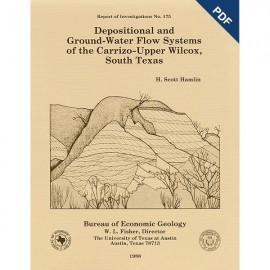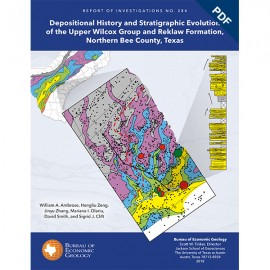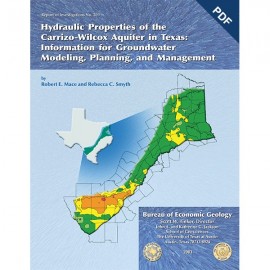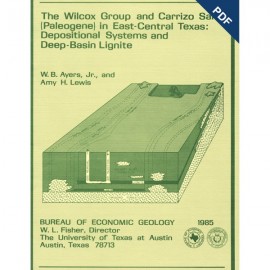Other Reports
-
Books & Reports
- Reports of Investigations
- Guidebooks
- Udden Series
- Geological Circulars
- Down To Earth
- Atlases of Major Oil and Gas Reservoirs
- Texas Memorial Museum Publications
- Environmental Geologic Atlas of the Texas Coastal Zone
- Mineral Resource Circulars
- Other Reports
- Seminars and Workshops
- Handbooks
- Submerged Lands of Texas
- Symposia
- Annual Reports
- Open File Reports
-
Maps & Cross Sections
- Thematic Maps
- Miscellaneous Maps, Charts & Sections
- Geologic Atlas of Texas
- STATEMAP Project Maps
- Geologic Quadrangle Maps
- Cross Sections
- Highway Geology Map
- Energy and Mineral Resource Maps
- Shoreline Change and Other Posters
- Wilcox Group, East Texas, Geological / Hydrological Folios
- Bouguer Gravity Atlas of Texas
- River Basin Regional Studies
- Featured Maps
- Posters
- Teachers & the Public
-
Geological Society Publications
- Gulf Coast Association of Geological Societies
- Alabama Geological Society
- Austin Geological Society
- Corpus Christi Geological Society
- Houston Geological Society
- Lafayette Geological Society
- Mississippi Geological Society
- New Orleans Geological Society
- South Texas Geological Society
- GCS SEPM Publications
- Historic BEG & UT Series
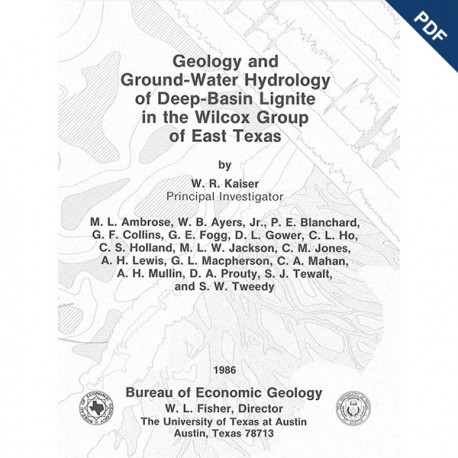
Geology and Ground-Water Hydrology of Deep-Basin Lignite in the Wilcox Group of East Texas. Digital Download
SR0010D
For a print version: SR0010.
SR0010D. Geology and Ground-Water Hydrology of Deep-Basin Lignite in the Wilcox Group of East Texas, by W. R. Kaiser, M. L. Ambrose, W. B. Ayers, P. E. Blanchard, G. F. Collins, G. E. Fogg, D. L. Gower, C. L. Ho, C. S. Holland, M. L. W. Jackson, C. M. Jones, A. H. Lewis, G. L. Macpherson, C. A. Mahan, A. H. Mullin, D. A. Prouty, S. J. Tewalt, and S. W. Tweedy. 182 p., 80 figs., 29 tables, 2 appendices, 1986. Downloadable PDF. To purchase this publication in book format, please order SR0010.
ABSTRACT
Lignite is an organic facies of Wilcox fluvial and deltaic systems and punctuates the vertical sequence at facies transitions. The thickest and most laterally extensive deep seams occur in Shelby, Panola, Robertson, Milam, Burleson, and Lee Counties. In the Sabine Uplift area, they occur in the lower Wilcox Group just above Midway shales and in east-central Texas in the lower Calvert Bluff Formation just above Simsboro sands. In a drilling and logging program, 29 holes were drilled and logged at a [1980s] cost of $337,805. Lignites can be identified with confidence on electric and induction logs in the presence of only a few density logs.
Regional ground-water flow patterns and aquifer (sand) trends in the Wilcox were mapped by integrating data on aquifer hydraulics and ground-water chemistry with aquifer (sand-body) geometry and sand content. Head maps show the direction of the force that drives ground-water flow, whereas hydrochemical maps show the actual ground-water movement. Depressuring and dewatering of deep-surface mines will probably be more difficult in discharge than in recharge areas and are a potential threat to regional water resources, whereas the effect on water quality is negligible. Chemical indices derived from Wilcox ground waters have been positively correlated with areas of recharge identified in head mapping. Belts and ribbons of high formation resistivity extend deep into the subsurface and reflect the focusing of ground-water flow by framework sands. Resistivity maps are tools for identifying the freshest, most productive aquifers.
Lignite was recovered from 18 seams and 5 stratigraphic intervals at a [1980s] cost of $33,608. Deep lignite is borderline subbituminous in rank. An increase in Na2O content with depth is correlated with increased Na+ in the ground water. Shelby and Panola County lignites are richest in Na2O, commonly exceeding IO percent in deeper seams. Among hazardous trace metals in Wilcox lignites, only selenium and arsenic concentrations exceed the average for U.S. lignite.
Keywords: lignite, Wilcox Group, Eocene, East Texas, east-central Texas, fluvial-deltaic sedimentation, groundwater, hydrogeology, hydrochemistry, chemical properties, hydrology, Sabine Uplift area, Texas
Citation
Kaiser, W. R., Ambrose, M. L., Ayers, W. B., and others, 1986, Geology and Ground-Water Hydrology of Deep-Basin Lignite in the Wilcox Group of East Texas: The University of Texas at Austin, Bureau of Economic Geology, Special Report SR0010, 182 p.

